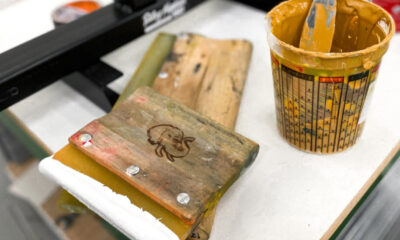Inks & Coatings
Published
10 years agoon

Doming is a finishing process that not only enhances the appearance of printed items by producing a three-dimensional look, but it also makes them more durable. The doming process relies primarily on three components: a dispensing system, resin, and a product with surface tension sufficient enough to accept and control the liquid doming resin during and after application.
Doming is a finishing process that not only enhances the appearance of printed items by producing a three-dimensional look, but it also makes them more durable. The doming process relies primarily on three components: a dispensing system, resin, and a product with surface tension sufficient enough to accept and control the liquid doming resin during and after application.
The basics
Essentially, the dispensing equipment draws or receives the doming resin from dedicated containers and then deposits the resin on the surface of a receptive product. Cutting a product to its final shape creates the requisite surface tension. Cutting a printed decal in a rectangular shape, for example, naturally sets up that decal to support a dome of the same shape. Once dispensed, the resin flows to the edges and stops at the boundary created at the cut (Figure 1). The end result is a lens-shaped coating—a dome—on that product.
Equipment
Dispensing equipment is available in numerous configurations and can accommodate products of varying shapes and sizes and job orders large and small. Here are some terms—associated primarily with machines that dispense two-part polyurethane resins—that you’ll likely encounter in your research:
Meter-mix Also referred to as meter-mix-dispense, this means the dispensing machine meters (measures) the resin components by volume and then mixes the components before depositing the resin onto the products.
Static mixer This refers to the dispensing machine’s mixing unit, which is responsible for blending resin components. A static mixer is often a simple, rigid, plastic tube that houses a series of helical elements. As both components of a two-part polyurethane resin enter the static mixer, they’re sheared and blended together when they pass over each element. The result is a homogenous mixture ready for deposit. Static mixers are common in dispensing equipment, whether entry-level or fully automated.
Dynamic mixer The dynamic mixer is similar to the static version in that it relies on the helical elements, but it also consists of a pneumatic motor that is integral to the dispense head. This motor complements the static mixer’s shearing and blending effect with rotary motion, which provides additional mixing.
Piston-metering systems Some dispensing machines rely on pistons to measure the resins. The pistons’ cylindrical housings are sized to conform to the volumetric ratio of the resin components, 1:1 and 2:1 being the most common. Upon actuation, the pistons push the precise amount of each toward the mixer.
Gear-metering systems These are another means used to deliver predetermined amounts of resin components to the dispensing machine’s mixer. The gears, controlled by servo motor, are machined with precise volumetric spaces between each tooth, which makes them the metering system. Controlled amounts of resin components are metered as they’re captured by the gears’ teeth.
Scripting This is a specialty technology. Dispensing machines designed to handle scripting jobs are traditionally high-end units that are driven by dedicated microprocessors. Scripting machines are made to follow complex paths and are capable of multiaxis movements, including x, y, and z, and some models feature a fourth channel that may address metering-system speed, rate of resin flow, or other operating factors. This fourth channel may be labeled differently or designed with a different purpose, depending on the manufacturer.
Taking the first step
Manually driven dispensing machines are available in tabletop and floor-oriented configurations and usually come with fixed dispensing heads. While they’re designed for doming lower volumes of product than the more automated machines, many are available with multinozzle, or manifolded, dispensing systems that allow you to dome entire rows of products at once (Figure 2). Some of these units may come with footswitches and other control options, but expect to index your sheets of printed products and move them along the production line by hand.
The next group of machines, tailored to meet higher production volumes, ranges from manual loading and unloading with automated x-axis-control dispense-head systems for doming repetitive products to machines that are capable of dispensing resins across x and y axes (Figure 3), are computer-driven, and either semi-automatic or fully automated in nearly every aspect of design.
If your printed products involve complex cut paths, such as cursive letters, and require more than a single shot of resin to create a dome, scripting technology is the way to go (Figure 4). Designed, as mentioned above, to dispense resins in multiaxis movements, scripting machines set themselves apart from other doming units in this respect. Control is the keyword in scripting technology. Scripting includes variables such as flow-rate modulation, point-to-point velocity management, and charting paths for resin dispensation.
Consumables
There are, perhaps, as many choices available in doming resins as dispensing equipment. Epoxies, one-part UV-curable polyurethanes, and two-part polyurethanes are the most common; however, the two-part polyurethanes enjoy a greater share of the resin market. Resins are shore tested for hardness. Softer, more flexible resins are best suited to applications in which curves, or more dramatic shapes, are present
While they require no mixing and generally cure faster than two-part resins, epoxies and one-part UV-curable polyurethanes are prone to yellowing and other reactions after prolonged exposure to the elements, and are therefore best suited to disposable products or those intended for indoor, short-term, light-impact use.
Two-part polyurethanes are made from polyol and isocyanate components, which are the resin and catalyst, respectively. A major consideration when working with two-part resins is the hygroscopic property of the isocyanate. If given the chance, the isocyanate will draw moisture from the air, and in turn, contaminate itself. This can happen before the two components are mixed or after they’re mixed and dispensed on the products. On the other hand, epoxies typically are not affected by most shop conditions. Each resin, regardless of chemical composition, requires safe handling. Even though doming resins may be relatively safe, some people will exhibit skin sensitivity to the materials.
Maintenance
Maintaining equipment and consumables is another major consideration. If unused portions of resins are properly stored, they will continue to perform as expected. You can insert desiccant cartridge filters into the storage tanks’ bleed valves to ensure that any air entering the tanks is dry and free of particulates. Lubrication and system cleansing are a major part of this routine—some machines have shafts, fittings, pump cups, and other points that you should tend to without fail. And, at the end of a shift, you can either flush the dispensing system with solvents or simply throw away some of the manifold components, such as tubing and nozzle outlets.

Subscribe

Magazine
Get the most important news
and business ideas from Screenprinting Magazine.
Most Popular
-

 Art, Ad, or Alchemy1 month ago
Art, Ad, or Alchemy1 month agoF&I Printing Is Everywhere!
-

 Case Studies1 month ago
Case Studies1 month agoHigh-Density Inks Help Specialty Printing Take Center Stage
-

 Andy MacDougall1 month ago
Andy MacDougall1 month agoFunctional and Industrial Printing is EVERYWHERE!
-

 Editor's Note1 week ago
Editor's Note1 week agoLivin’ the High Life
-

 Columns2 weeks ago
Columns2 weeks ago8 Marketing Mistakes Not to Make When Promoting Your Screen Printing Services Online
-

 Thomas Trimingham2 months ago
Thomas Trimingham2 months ago“Magic” Marketing for Screen Printing Shops
-

 Marshall Atkinson1 week ago
Marshall Atkinson1 week agoHow to Create a Winning Culture in Your Screen-Printing Business
-

 Press Releases2 months ago
Press Releases2 months agoBig Frog Custom T-Shirts & More of Round Rock Celebrates Grand Opening





